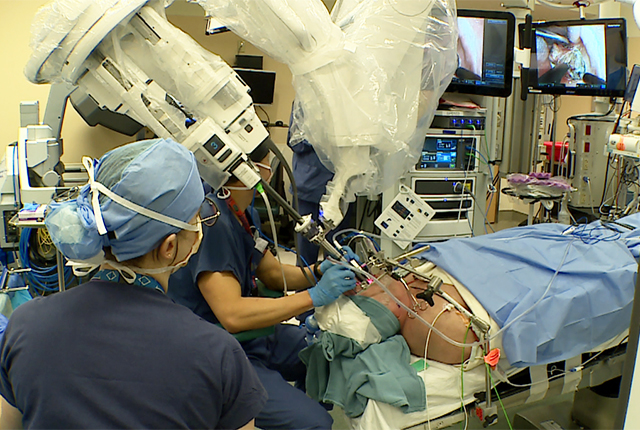TORS( Transoral Robotic Cancer)
Transoral Robotic Surgery (TORS) is a minimally invasive surgical technique used in head and neck surgeries. It involves the use of a robotic surgical system to perform procedures through the mouth, eliminating the need for traditional open surgery. TORS is particularly well-suited for certain head and neck cancers.
Dr. Sowrabh Arora has 20 years of experience and is one of the best head & neck tumor surgeon in Noida, India. With his expertise in treating complex head and neck tumors, he is dedicated to providing advanced surgical care and personalized treatment plans for optimal outcomes.

Here are key points about Transoral Robotic Surgery (TORS) :
1. Procedure Overview:
- TORS involves the use of a robotic system, which typically includes a console for the surgeon to control the robot and robotic arms equipped with surgical instruments.
- The surgeon guides the robotic arms through the patient's mouth to access tumors or affected areas in the head and neck.
2. Advantages:
- Minimally Invasive: TORS is minimally invasive, resulting in smaller incisions and less impact on surrounding tissues.
- Enhanced Precision: The robotic system provides enhanced precision, dexterity, and a three-dimensional view for the surgeon, improving the accuracy of the procedure.
- Quicker Recovery: Patients undergoing TORS often experience a faster recovery compared to traditional open surgeries.
3. Indications:
- TORS is commonly used for treating certain head and neck cancers, including tumors of the throat, tonsils, tongue, and other areas accessible through the mouth.
4. Conditions Treated:
- Oropharyngeal cancer
- Tonsil cancer
- Tongue cancer
- Base of tongue cancer
- Other tumors in the oral cavity and throat
5. Procedure Steps:
- The surgeon controls the robotic system from a console, directing the robotic arms equipped with instruments to remove tumors or perform other necessary procedures.
- The robotic system provides a magnified, high-definition, 3D view of the surgical site, allowing for precise movements and optimal visualization.
6. Recovery:
- Because TORS is minimally invasive, patients often experience shorter hospital stays and faster recovery times compared to open surgeries.
- The outlook depends on factors such as the type and stage of cancer, age, and overall health.
- TORS is commonly used for treating certain head and neck cancers, including tumors of the throat, tonsils, tongue, and other areas accessible through the mouth.
4. Conditions Treated:
- Oropharyngeal cancer
- Tonsil cancer
- Tongue cancer
- Base of tongue cancer
- Other tumors in the oral cavity and throat
5. Procedure Steps:
- The surgeon controls the robotic system from a console, directing the robotic arms equipped with instruments to remove tumors or perform other necessary procedures.
- The robotic system provides a magnified, high-definition, 3D view of the surgical site, allowing for precise movements and optimal visualization.
6. Recovery:
- Because TORS is minimally invasive, patients often experience shorter hospital stays and faster recovery times compared to open surgeries.
- The outlook depends on factors such as the type and stage of cancer, age, and overall health.
- Oropharyngeal cancer
- Tonsil cancer
- Tongue cancer
- Base of tongue cancer
- Other tumors in the oral cavity and throat
5. Procedure Steps:
- The surgeon controls the robotic system from a console, directing the robotic arms equipped with instruments to remove tumors or perform other necessary procedures.
- The robotic system provides a magnified, high-definition, 3D view of the surgical site, allowing for precise movements and optimal visualization.
6. Recovery:
- Because TORS is minimally invasive, patients often experience shorter hospital stays and faster recovery times compared to open surgeries.
- The outlook depends on factors such as the type and stage of cancer, age, and overall health.
- The surgeon controls the robotic system from a console, directing the robotic arms equipped with instruments to remove tumors or perform other necessary procedures.
- The robotic system provides a magnified, high-definition, 3D view of the surgical site, allowing for precise movements and optimal visualization.
6. Recovery:
- Because TORS is minimally invasive, patients often experience shorter hospital stays and faster recovery times compared to open surgeries.
- The outlook depends on factors such as the type and stage of cancer, age, and overall health.
- Because TORS is minimally invasive, patients often experience shorter hospital stays and faster recovery times compared to open surgeries.
- The outlook depends on factors such as the type and stage of cancer, age, and overall health.
It's important to note that not all head and neck surgeries are suitable for TORS, and the choice of surgical approach depends on various factors, including the type and location of the tumor, as well as the patient's overall health. The decision to use TORS is typically made by a multidisciplinary team of healthcare professionals.
Dr. Sowrabh Arora is one of the best head and neck tumor surgeon in Moradabad, India. He specializes in diagnosing and treating head and neck tumors with advanced surgical techniques, ensuring precise and effective care for his patients.


 Max Hospital, Vaishali, Gaziabad
Max Hospital, Vaishali, Gaziabad